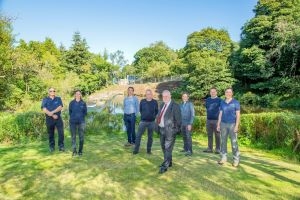New fish pass to boost ecology of River Almond
Work is set to start on a new fish pass at Mid Calder Weir.

The £670,000 project will see the current large weir altered to help the free passage of migratory fish species up the Almond.
The work is part of the RiverLife: Almond & Avon - Almond Barriers Project, which aims to improve the ecological condition of the river.
West Lothian Council is leading on the delivery of the project in West Lothian, which will involve contractor Barhale Limited altering the existing weir to include a two-flight fish pass.
Executive councillor for the environment Tom Conn said: "I'm delighted that work has started on the new fish pass at Mid Calder Weir.
"The River Almond is an important resource that runs through the heart of West Lothian, and this is another key step forward towards restoring the Almond to the best condition possible."
The Scottish Environment Protection Agency (SEPA) identified that physical barriers across rivers were preventing migrating fish, and adapting them would make over 200 km of river accessible to migratory fish once again.
Although most mills have since disappeared, many of the barriers remain and continue to negatively affect the quality of rivers, including the Almond & Avon.
Francis Hayes, River Restoration Specialist at SEPA, said: "SEPA is delighted to see the work begin on this section of the River Almond as part of the larger catchment scale project. We are working with key partners to reverse some of the historical harm to benefit the river, the wildlife it supports and the communities living beside it.
"Rivers are a vital part of our landscape and a great asset to Scotland, providing wildlife corridors, opportunities for recreation and wellbeing and resources for local communities. We acknowledge the multiple challenges currently facing the River Almond and it is important we work together with partners to tackle these issues for the future benefit of the river and the communities who use and enjoy it.
"This weir project will, in time, bring significant benefits for the local area by making over 200 km of river accessible to migrating fish for the first time in generations. We look forward to seeing resilient fish populations return to the river network once more and provide wider environmental benefits for wildlife and neighbouring communities."
The Almond Barriers Project is being delivered in a partnership between West Lothian Council, City of Edinburgh Council, Forth Rivers Trust and the Scottish Environment Protection Agency with investment from the Scottish Government, SEPA's Water Environment Fund and the National Lottery Heritage Fund.
It was brought together under RiverLife: Almond & Avon, an ambitious programme of physical improvements aimed at helping turn around the fortunes of the Rivers Almond & Avon, whilst engaging with people in the communities which the rivers pass through.
Alison Baker, Director of the Forth Rivers Trust, said: 'Ensuring that fish species can migrate within rivers and out to the marine environment is critical for their survival. These iconic species include Atlantic salmon, trout (both resident brown and migratory sea trout), European eel and lamprey.
"These species are of huge significance to the river Almond not just for themselves but for the ecology which they support including otters, kingfishers, etc. Unlocking fish passage at Mid Calder is very welcome as part of the ongoing work throughout the catchment."
The current Mid Calder Weir is 65 meters long and 2.5 meters in height. The current weir was constructed in the early 19th Century on top of the previous weir, with evidence of a similar structure on the site dating as far back as the 16th Century.
Weirs were originally constructed to provide power to mills, which would have processed grain from surrounding farms. A fish pass was installed 40 years ago, but has proven ineffective.
The free passage of migratory fish species is a key indicator of 'good' ecological condition of the river, so it is critical that all these barriers are adapted to improve fish passage.
Construction access will be along Almondell Terrace and through East Calder Wastewater Treatment Works. The works will also require the temporary closure of the riverside footpath, which is also part of National Cycle Route 75, in the interests of safety. A signed diversion will be put in place.



